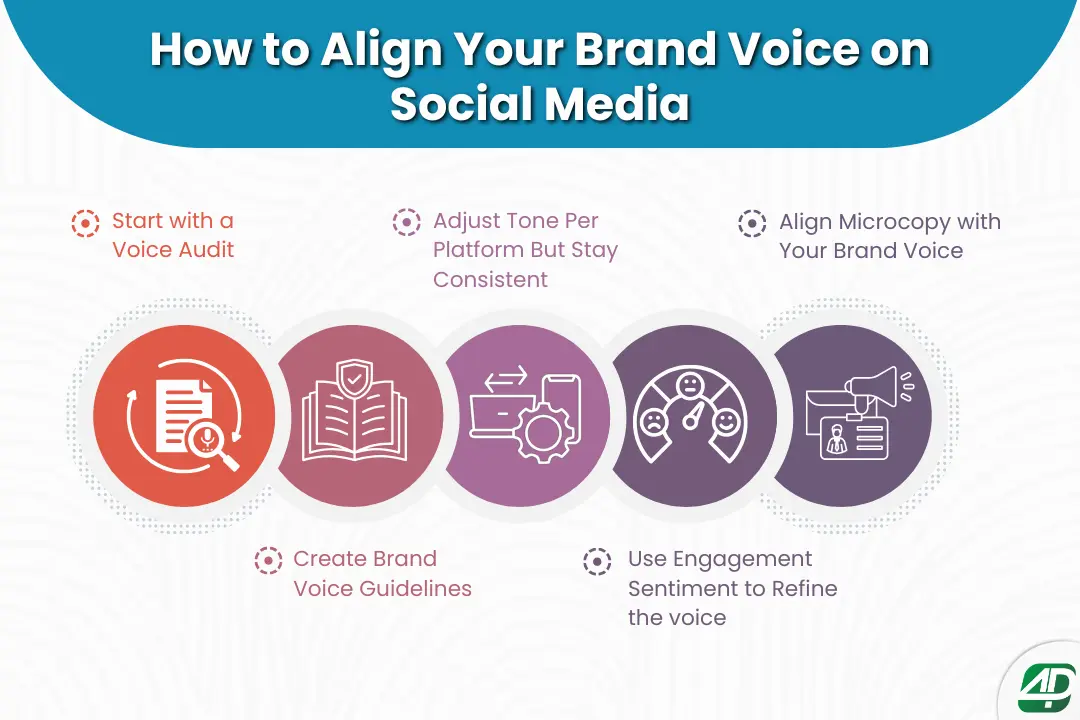Introduction
Your brand is more than a logo. It is how people feel when interacting with your business. And on social media, your brand voice is one of the most powerful ways to connect. But let’s be honest: keeping that voice consistent across all platforms, posts, and messages is easier said than done. But the great thing is you don’t need to micromanage every caption or graphic. You need clarity, not control.
In this blog, we’ll explain what brand voice means, why it’s essential for your social media brand strategy, and how to align it across platforms without overwhelming your team.
Highlights:
What is Brand Voice?
Think of your brand voice as your personality in other words. It’s how you speak to your audience, through captions, comments, hashtags, and every piece of content. It's shaped by your tone, vocabulary, sentence structure, and emotional style.
For example, a playful D2C skincare brand might say, “Glow up, bestie,” while a luxury real estate brand might go with, “Crafted elegance in every square foot.” Both are saying similar things, but in completely different voices that match their brand.
Let's see how one can incorporate the brand voice in your social media posts, captions and stories.
How to Align Your Brand Voice on Social Media

Here’s where most brands fail, they try to control every little detail on their social media. Here's how to do it effectively:
1. Start with a Voice Audit :
Review your existing posts across social platforms, Instagram, LinkedIn and YouTube. Are you casual on one channel but too corporate on another? Brand voice audit is the process which helps you spot tone mismatches or brand voice drift over time.
For instance, a fintech brand might notice that their YouTube feels approachable, while LinkedIn sounds too stiff. Spotting and fixing this gap is key to achieving brand consistency on social media.
2. Create Brand Voice Guidelines :
After figuring out your voice, write it down as a clear guide. Include your tone (friendly, formal), word choices (clients or customers), use of emojis, and humor style. This helps your team stay consistent without needing your constant review. For example, a SaaS brand might say, “Be professional but not robotic”.
3. Adjust Tone Per Platform But Stay Consistent :
Every social platform has its style. Your tone can change slightly, but it should always sound like the same brand. For example, a fashion brand might be playful on Instagram with “Serve looks, not stress,” but more professional on LinkedIn with “The fashion supply chain needs innovation.” The tone shifts, but the personality stays the same.
4. Use Engagement Sentiment to Refine the voice :
Engagement is more than numbers, it’s about how your audience feels. Pay attention to their comments and messages. Do they respond to humour or behind-the-scenes stories? For example, a food brand found that its best engagement comes from posts about late-night cravings, not promotions. So, it made its voice more relatable and lifestyle-focused.
5. Align Microcopy with Your Brand Voice :
Small texts like buttons, CTAs, hashtags, and auto-replies matter a lot. Even one word can make your brand voice stronger or weaker. For example, a productivity app might use “Let’s Go” instead of “Start” to sound more energetic and on-brand.
Why Brand Voice Matters on Social Media
If your tone changes every time you post, it confuses your audience and weakens brand trust. A consistent voice builds familiarity, which makes people more likely to engage, share, and eventually buy. That’s why brand consistency on social media isn't just a creative choice, it's a business one.
Social media is where brands can interact with their potential audience in real-time. One off-brand tweet or caption can shift perception instantly. A clear and consistent brand voice makes your messaging feel intentional, not accidental.
Automation helps, but strategic human insight makes the difference.
Do’s and Don’ts of Brand Voice on Social Media
Below are do’s and don’ts of the brand, which will give you a better perspective on how to post a clear tone message on social media.
|
Topic |
Do’s |
Dont’s |
|
Voice Guidelines |
Build a brand voice guidelines and update it |
Don't assume that your team knows what voice to follow |
|
Platform Usage |
Adjust your messaging per platform while staying true to your voice. |
Don’t copy-paste captions blindly across every channel. |
|
Content Review |
Run monthly voice alignment checks as part of your audit. |
Don’t rely only on design and visuals for brand identity. |
|
Flexibility |
Empower your team with flexible templates to experiment creatively. |
Don’t restrict creativity with over-complicated approvals or rules. |
How 4P Solutions Helps You Build a Strong Brand Voice
At The 4P Solutions, India’s leading B2B Digital Marketing Agency, we don’t just offer content, we co-create your voice. We begin by helping you define your brand’s tone across key pillars: customer experience and business goals. Whether your brand tone is bold and visionary or empathetic and approachable, we ensure every post, ad, and caption speaks the same language.
Beyond documentation, we monitor how your voice performs in the real world.Using performance analytics and audience feedback, we refine your tone across content buckets, seasons, and campaign goals so your voice evolves while staying authentic. This integrated approach helps you achieve stronger brand consistency on social media and long-term impact.
Conclusion
Creating a consistent brand voice on social media doesn’t mean sounding robotic or repetitive, it means being memorable and trustworthy in every interaction. Whether you’re a startup or an established business, a well-defined voice can elevate your social presence from noise to narrative.
And if you’re unsure where to begin, partner with The 4P Solutions. We are a B2B social media marketing agency, specialising in aligning voice with your business goals while making your content strategy more effective. Let’s create a brand voice that not only fits but lasts.
FAQs
Brand voice is your brand’s personality. Tone changes with context, like being friendly in a campaign and calm in a complaint.
Your voice stays the same. But your tone and style can flex to match the platform and audience.
Tools like Loomly, ContentCal, or even shared Google Docs help teams stay aligned through planning and feedback.
It happens when there’s no clear guideline, or teams chase trends without checking if they match the brand's voice.

